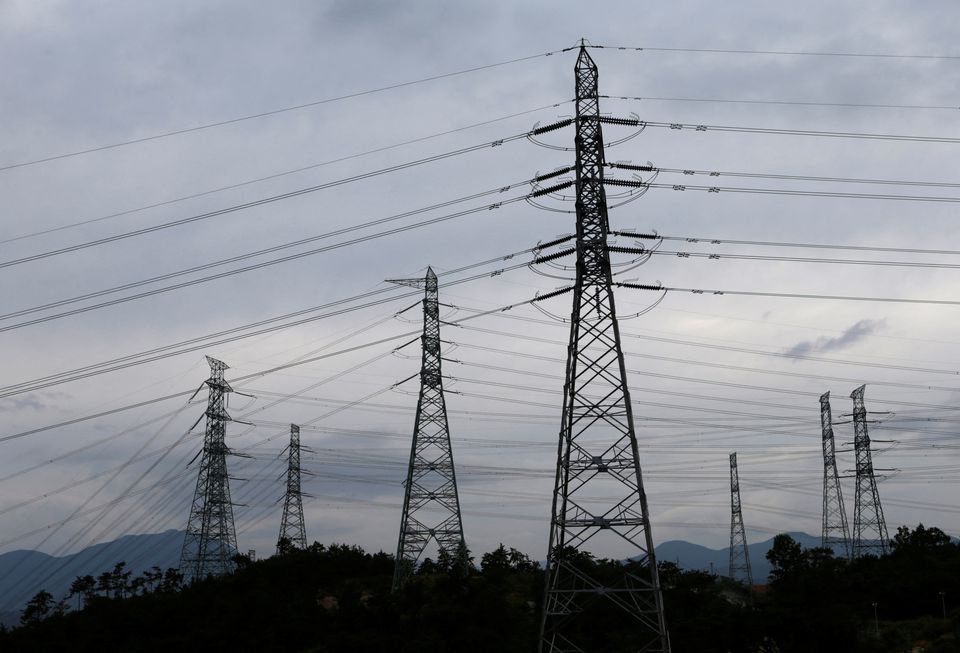
South Korean and Japanese power utilities are sustaining heavy losses, kept from passing rising generation costs on to customers and, according to analysts, forced to reconsider the timing of green investments.
The industry is squeezed between high costs of imported fuel, exacerbated by weak currencies, and government unwillingness to displease voters and worsen inflation with price rises.
During the first nine months of this year, state-run electricity distributor Korea Electric Power Corp (KEPCO) reported record operating losses of 21.83 trillion won ($16.69 billion) on revenue of 51.8 trillion won, compared with a loss of 1.12 trillion won a year earlier.
KEPCO is staying afloat with bond issuances and bank loans. Debt had already reached 223% of equity capital at the end of 2021.
However, President Yoon Suk-yeol's approval rating, just 39% this month, is too low for him to dare to allow a bigger rise in electricity prices than the approximately 13% approved for this year and a similar one for 2023, analysts said.
"In order for KEPCO to swing to profit, we estimate electricity prices must be at least 30% to 40% higher than last year, or the Dubai oil spot price must fall to pre-COVID levels," said Na Min-sik, analyst at SK Securities.
KEPCO said it had no plans to cut maintenance budgets or facilities investments.
But analysts told Reuters that KEPCO's capital spending would drop about 20% next year. Items likely to be cut would be improvements to transmission grids to support highly variable electricity flows from renewable sources, they said.
"Since renewable power fluctuates, investment is necessary in transmission infrastructure to grow the portion of renewables in energy mix," Na said. "But it's a burden, as 30 trillion won in losses are forecast this year, and continued losses next year."
Another analyst said: "Out of new power plant construction, maintenance of existing plants and power grid infrastructure, the biggest delays will be in new power plant construction, especially in renewables."
WHOLESALE PRICE CAP
Moreover, South Korea this month decided to cap for at least three months the base rate at which KEPCO buys electricity wholesale from generation firms.
This will discourage investment in renewable generators, according to an industry association.
"We estimate this could cost us revenues of 90 won per kilowatt. If this cap is extended for a year, it would cost a 10 megawatt generator 100 million won," said Jung Woo-sik, an executive at lobby group Korea Photovoltaic Industry Association. "We'll lose investments. This will cripple the renewables industry."
As for Japan, nine out of 10 key regional electricity utilities booked a net loss for the April-September half-year, with five companies reporting record losses for the period.
All eight utilities that have announced an annual forecast for the fiscal year to March 31, 2023, have warned of a net loss. Tokyo Electric and Kyushu Electric did not provide full-year outlooks.
Most of those that have applied for price rises have said they would maintain green investment, but analysts expect some deferral.
"Investment towards decarbonisation by Japanese utilities may be delayed as the companies seeking to hike prices are saying that they would review all new investments," said Toshinori Ito, president of Ito Research and Advisory which specializes in energy markets.
By the end of November, five out of 10 major regional utilities had applied to raise prices by between 28% and 46% from April.
They said their financial situation had deteriorated sharply due to soaring fuel prices due to Russia's invasion of Ukraine and the yen's plunge against the U.S. dollar. That could hinder stable supply of electricity, they said.
The Japanese industry ministry will examine whether each company's efforts to improve management efficiency, such as reducing labour costs, are sufficient.
($1 = 1,308.2600 won)